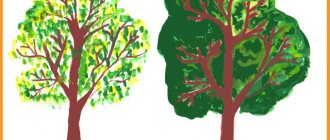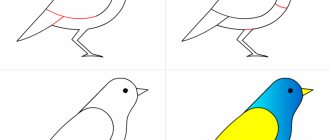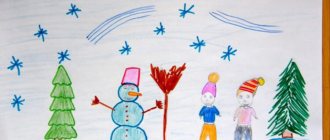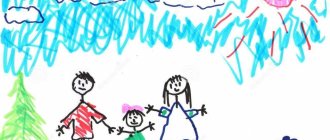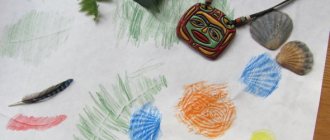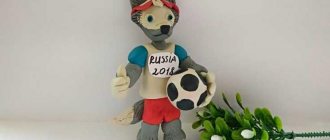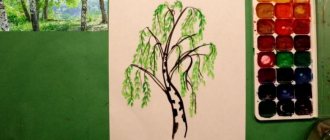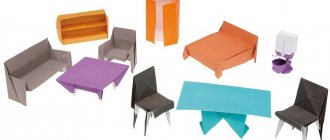Representatives of the bird world are found in nature in an amazing variety, they symbolize the sky, freedom, life and abundance. Sketches of birds often appear in children's albums.
Drawing birds is not only exciting, but also educational, because children get acquainted with forest, domestic and exotic species.
Parents should tell their child about their value to the natural environment, their anatomical structure and differences, sometimes even watching the winged singers from the window and feeding them in the winter.
How to draw a bird
The process of drawing birds will be greatly simplified if you follow the recommendations and practice regularly, improving your hand. Master classes will be useful for children of all ages, helping them cope with the difficult task of mastering artistic skills.
Owl
Let's try to recreate this expressive image step by step:
- Work begins with two circles with cross-shaped lines at the smaller top figure.
- We outline them with smooth lines, continuing the back part, ending with the tail.
- We finish drawing the legs with three toes.
- We depict round eyes with eyebrows and characteristic ears.
- Below we place a beak that looks like a hook.
Now we need to display the plumage, which lies in rows on the wing, tail, and the fluff on the chest, conveyed by shading. The pencil drawing of the bird is ready.
Penguin
Not a flying, but a floating specimen, recognizable from cartoons and movies, also belongs to the family of birds; its appearance is not difficult to reproduce in profile. You will need to outline a vertical egg ending in a small head with a beak. Draw a short tail and legs.
The most important thing is to correctly paint the picture with paints or felt-tip pens - the head area, the back with wings-flippers are black, and the abdomen is white.
Chick
The proposed version of the image of a chick is simple. We draw an arc from bottom to top, ending with an arrow-nose. We draw the eyeball with the pupil side by side. From the arrow we continue the bow to the starting point, ending it with a tail. We draw on the arched wing and thin legs.
Parrot
Many people keep these bright individuals at home; let’s draw a striking bird step by step:
- We sketch out a diagram of 2 ovals, on the left we draw a back line that turns into a falling tail.
- We use a semi-rounded ruler to mark the bottom of the wing.
- Draw the beak-hook, eyes-circles and paws.
We proceed to contrasting coloring, conveying the feeling of feathers. We use red, blue, yellow. Using a black tone we highlight the base of the beak and the edges of the feathers.
If you want to capture a parrot in flight, use a pair of arched rulers to show outstretched wings with an arched lower edge; its face will be half turned towards us, complemented by a beady eye and a hump nose.
Woodpecker
The cautious and beautiful little bird, by knocking on a tree trunk, not only gets food for itself, but also lets other “relatives” know about the boundaries of its territory, attracting females in the spring. Procedure:
- We draw an oval head and a body with extending wings.
- We draw the line of the beak, legs and move on to the hanging tail.
- We detail the wing by tracing the contours and highlighting the feather strokes.
- We remove unnecessary lines and refine the eye.
Decoration will add realism - a red head, a white chest. We emphasize the beak and other body fragments with black coloring.
Stork
This handsome guy has long legs, an ovoid body and a small head with an elongated yellow nose. Having completed the sketch, we clarify the details. Using a series of rulers we draw out the raised wings.
The ankle-shaped, yellowish limbs have a thickening in the middle. The aerial inhabitant has a snow-white color with a gray-blue tint at the tips of the plumage. Using strokes we emphasize the fluff in the chest area.
If you take on a heron, then give its neck a greater bend, and draw a crest on the back of its head, let it keep its balance on one limb, tucking the other, as it is more accustomed to do when hunting for river life.
Bullfinch
Let's depict a small bird with a colorful appearance that does not fly away to hot countries for the winter:
- Draw an oval body and a circle head.
- From them we draw a line that turns into a wing.
- We fix the neck and tail segment.
- The paws will tenaciously hold on to the branch.
We paint the figure - a bright red breast, a white spot under the eye, reminiscent of a bead with a dot, highlighted darkened plumage.
flying seagull
At first, the task seems difficult, however, even a child can do it:
- A round head and an elongated body with a lower convexity are outlined.
- The near wing has a more elongated format compared to the far element.
- The continuation of the figure will be the tail.
- The bird's legs are folded and pressed.
- We display zigzag feathers more accurately.
Hatching shows the fall of the shadow. It is worth noting that the dimensions of the wings of flyers increase in direct proportion to the size of the body.
Summary of drawing lesson “Bird on a branch” (senior group)
Natalia Voronina
Summary of drawing lesson “Bird on a branch” (senior group)
Notes on drawing "
Bird on a branch " (
senior group ) .
Notes on drawing "
Bird on a branch " (
senior group ) .
- expand and consolidate children’s generalized ideas about wintering and migratory birds, teach them to classify into wintering and migratory birds;
— to develop in children the ability to draw a bird , conveying the shape of body parts and beautiful plumage; practice drawing with wax pencils;
- teach children to make a sketch with a simple pencil;
-develop figurative perception, imagination;
- be able to convey your impressions and observations of birds drawing
Equipment and materials: A4 album sheets, wax pencils, simple pencils, an easel, three envelopes of different colors, pictures depicting migratory and wintering birds, a bird drawing .
Small breeds
Sparrows are the most common family; their oval body is equipped with a round head and a triangle-beak. Draw the wing, eye and thin legs. An interesting titmouse with a round yellow belly.
The smallest bird is the hummingbird, which is distinguished by its long nose, thickened at the base, with which it drinks nectar from flower buds; it has also earned fame for its ability to fly backwards. The picture will turn out believable if you carefully work out the feathers of the birds.
Crow
Flocks of crows have chosen places close to humans; these birds are smart and intelligent. We offer a way to draw this bird easily and simply:
- On one diagonal we draw contour sketches of the head and torso, thickened towards the bottom and a triangular tail.
- We connect these parts with a stroke, completing the beak and two paws with claws.
- We detail the wing and give the tail a flat appearance.
- Having removed the basting, we move on to the plumage.
- Inside the eye we designate a highlight; an additional curve goes from it to the beak.
You can start shading with a black pencil, emphasizing the feather coating with contrast. If you choose the image of a magpie, then remember its peculiar black and white coloring and long tail.
Abstract of GCD for drawing “Birds of Migratory”
MARINA CHERNYAK
Abstract of GCD for drawing “Birds of Migratory”
GCD for drawing “ Birds of passage ”
with children 5-7 years old
teach children to sketch birds in motion , conveying the basic shape and main parts. Without drawing the details of the plumage . Practice sketching with one pencil or one paint. Consolidate and expand knowledge about wintering and migratory birds . Cultivate a caring attitude towards birds .
birds flying south ; reproduction of Stepanov’s painting “The Cranes Are Flying”
.
Unusual specimens
There are varieties that cannot be confused with anyone else. For example, this is an overweight pelican, with a beak-bag where it stores fish, or a toucan with a special structure of a voluminous nose-beak.
Pink flamingos on elongated legs are graceful and spectacular, and the nimble swallow is distinguished by its forked tail and erected hut nests.
The highlight of the peacock is a chic blossoming fan-tail with diamond-shaped colored patterns, and its head is crowned with a “crown” of corollas with circles.
Let's depict a formidable eagle:
- We make a general sketch of the body with all its fragments.
- We start detailing from the head with a slightly open beak-hook and an eye with a pupil under the eyebrow.
- We approach the back, lowering ourselves onto the tail section.
- The sitter has sharp claws on his large paws, and specific “pants” on his shins.
- We convey the plumage on the powerful wings by shading.
We draw the stump on which the predator is sitting.
Graceful swans are impressive, associated with fidelity and love. The simplest version begins by drawing the number two flowing into the body rocking on the waves. These birds have a characteristic marking on their wide beak and webbed feet.
Fairytale variations
The firebird from the fairy tale has sweeping fan-like wings and a flowing plume-tail, a non-trivial fiery coloring, performed at its own discretion.
It is filled with figural patterns of different colors, from which streaks radiate, comparable to hair. Next, you need to blacken the edges of the plumage and fix the head crest.
Also interesting is a character who has an unusual, bright appearance. This is a circle with a polygonal beak, on the sides of which there are huge eyes with the obligatory “bags” under them. There is a crest on the head and a miniature tail on the left. You can start coloring.
Dove of peace
When thinking about how to draw a bird for children, remember the dove - a fluttering creature with a flowering twig in its beak, which is a symbol of peaceful life.
Having outlined the oval body and the circle head, they are combined by adding a carved tail. The wings, open to the sides, can be compared in shape to an inverted trapezoid. The final stroke is to give the edges of the feathers fragmentation with zigzags.
Of course, it is impossible to cover all the inhabitants of heaven. Starting with one image and strengthening your skills, move on to the next example. Children will certainly enjoy this exciting pastime, which not only develops fine motor skills, but also expands their horizons and knowledge about the earth's fauna.
Notes on drawing in the senior group “Birds fly south”
Ekaterina Kleeva
Notes on drawing in the senior group “Birds fly south”
SUMMARY OF NODES ON DRAWING IN THE SENIOR GROUP
«BIRDS FLY SOUTH»
ART TEACHER: KLEEVA E. V.
PROGRAM CONTENT: teach children to sketch birds in motion , conveying the basic shape and main parts. Without drawing the details of the plumage . Practice sketching with one pencil or one paint. Consolidate and expand knowledge about wintering and migratory birds . Cultivate a caring attitude towards birds .
MATERIALS: Landscape sheets tinted with blue-violet color (autumn sky, simple pencils, wax crayons; illustrations depicting birds flying south ; reproduction of Stepanov’s painting “The Cranes Are Flying”
.
CONNECTION WITH OTHER EDUCATIONAL AREAS: Watching birds while walking , paying attention to their varied movements
